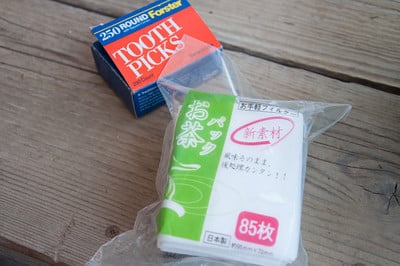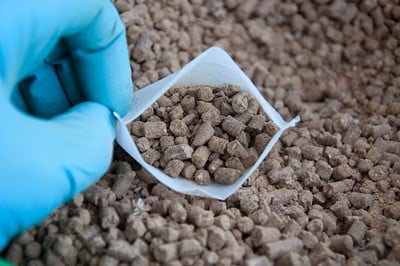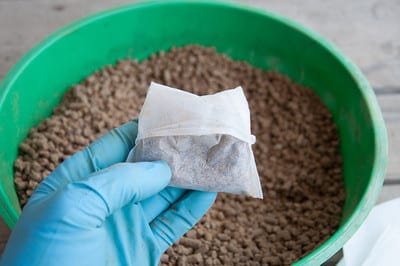Every year I experiment a bit with fertilizer and every year I seem to keep returning to my standard duo – cottonseed meal and fish emulsion. Although they’ve worked well for my trees, I’d like to try a more balanced mix this year. The fish emulsion I use is rated 4-1-1, the cottonseed meal, 6-2-1 – neither providing much phosphoric acid or potash. Boon has used Phyta-Grow brand fertilizer from California Organic Fertilizers, Inc. for years so I thought I’d give it a try this year. We’re using a 50-50 mix of the Pre-Plant PlusTM (7-5-7) and the Veggie MixTM (8-5-0.5) for a combined 7.5-5-3.75.

Equal parts Pre-Plant PlusTM and Veggie MixTM
As I’ve done with the cottonseed meal in the past, I filled tea bags with the fertilizer and held the bags in place with toothpicks.

Toothpicks and tea bags

Filling a bag

Folding it shut
My primary obstacle to using more balanced fertilizers in the past has been the critters that run off with the bags in the night. They tend to leave cottonseed meal-filled bags alone, but whenever I place anything more interesting inside, they don’t seem to last more than a few days before vanishing. Just a week after trying this new mix, the first few bags have already been torn up, but I’ll wait and see how the rest of the lot fares before switching back to cottonseed meal alone.
Subscribe to Bonsai Tonight
New Posts Delivered Every Tuesday and Friday
Zack Clayton says
I feel your pain on the disappearing bags. I tried poo balls of various formulations and I have always returned to generic garden starter, vegetable, or bloom formulations from the big box stores. My plants do well with the balanced NPK ratios and I just sprinkle it on the top of the soil. It’s unobtrusive and nothing seems to be attracted to it. I have noticed no difference in performance between organic and non-organic versions, only on price. With a little moss at showtime the grains are also invisible. I have had no problem with salt build up. By varying the brand I get a good mix of micronutrients. Just a thought on this, but as I tell our beginner classes, “The best soil mix is the one that works for you, in your yard.” I guess the same would be true of fertilizer.
Matthiew Quinn says
You could always try a Dosatron Jonas. We use this at the botanical gardens here in Montreal. It will cost you a pretty penny at first(machine and installation should cost around 600-700$) but then for the next 10-20 years you have a machine diluting fertilizer into your water hose as you water. You just need to do a little math and prepare a fertilizer concentrate in a bucket, hook it to the machine and then each plant gets what he needs depending on how thirsty he is.
Presently we are using chemical fertilizers at 100 ppm. One week it’s a acidifying fertilizer, the next it’s a fertilizer rising the Ph… thus Ph stays stable.
There are also biological formulas you can dilute into the concentrate bucket if you wish to stay away from chemicals… but we have noticed that mycorrhizae still thrives with these low ppm rates.
And as for the rates of Nitrogen-Phosphore-Potash, don’t worry too much about having low Phosphorus as a high number here can make your internodes elongate and actually stump root growth. You need some, but if you have a 15-5-15 it’s considered good. This rate is actually considered the new “balanced” fertilizer.
This all might seem complicated,but your a smart guy and when you understand it, it’s really handy.
I hope this has given you ideas, you seem like an adventurous type.
This is just a little N-P-K for thought (food for thought haha).
Matt
Chris says
Exact same experience Jonas. I can’t keep anything on the trees overnight if it contains anything other than cottonseed. Very aggravating. So Im stuck with chemicals.
Roger case says
Have you ever tried using old nylon stoching toe poeces to hold fertilizer they dont tear ss easily and can be reused. Often they are available asvhoodwill stores
Jonas Dupuich says
Thanks, all, for the comments – the experiments will continue. I have yet to try nylons, but fear the offending creatures will run off with those too! The Dosatron sounds like a good idea – I’ll keep that in mind every time I get out the fish emulsion. And I’m happy to hear 15-5-15 (3-1-3) is a good target balance. I’ll root around and see what else I have at my disposal and will report back if I come up with anything interesting.
brendenstudio says
My solution to this problem is bird netting; I cut a strip off the roll about a foot wide then roll it into a tube which I gently place around the trunk of the tree to the outer edge of the pot. I secure the netting to the pot using bamboo skewers. This creates a physical barrier of netting above the soil and allows you to water through it and keep an eye on the soil surface. Prior to that I was using the mesh bags that melons come in at the grocery store. I find the bird netting is more effective.
japanesepots says
I’ve also had the same experience with organics in bags. Not only do critters steal them, but in my climate and humidity they produce very annoying(but harmless) fungus gnats. The dosatron is pricey but looks nice, I used an EZ Flow last year but need to get another.
andy kasper says
Jonas,
How many bags do you put on a pot? Also, do you just keep adding bags or refill the ones on it already? How often? andy
Jonas Dupuich says
Hi Andy, good question – it really depends on the tree. I usually start trees that appreciate a lot of fertiler with 2-4 bags depending on the size of the tree and add a few more bags as the season progresses. Because I use liquid fertilizer regularly I don’t have to rely completely on the bags so I don’t use as many as I might otherwise. I use fewer bags with trees that require less fertilizer like deciduous trees and white pines in spring. I don’t have a good way of checking when the utility of the bags is spent. In the past I’ve replaced some of the oldest bags with new bags mid-way through the growing season. I never reuse old bags as they’re often starting to fall apart at that point.
don says
Jonas,
Is there a local store where I can purchase the fertilizer from California organic fertilizer?
andy kasper says
Thank You.
Usually I make balls with Holytone or Plantone and due weekly foliar feeding with miracle grow. I’m going to try a few with the bags to see if that helps with the soil being clogged up, like with the balls.
Mark @ Bonsai Dojo says
Have you tried using worm wee as fertilizer? I used to use fish emulsion too but made the change to worm wee a few months ago and haven’t looked back. We got a worm farm so its pretty much free and has done wonders for the growth of my Bonsai, though you have to watch out not to add too much or you can burn the root (dilute 20:1)
John Demaegd says
I was wondering why you put the fertilizer in bags? Why not jut let it break down in the soil?
Jonas Dupuich says
Hi John – the main drawback to sprinkling fertilizer on the surface of the soil is decreased drainage resulting from fertilizer breaking down and filtering through the soil. Plus, cleaning up spent fertilizer bags is fast and easy. I’ve used piles of fertilizer on the soil surface for years and will continue to do so, but will use the bags whenever possible for convenience/drainage.
Mark – I haven’t tried worm tea but have heard good things about it – as long as it’s diluted properly. If I come across some (or find a worm farm) I’ll give it a go.
Don – I get the fertilizer at Harmony Farm Supply in Sebastopol: http://www.harmonyfarm.com/
Tina says
I was just watching a video of a Taiwanese nursery/container/bonsai market and some of the bigger posts had four or more nifty metal blossom shapes, almost a cage. if something like that was made of metal, or pottery, on spikes, maybe with hinged door on the bottom, would they work? https://www.youtube.com/watch?v=q1obAwLhT8E at 2:12 of this? just an idea…or maybe someone knows more and where available?